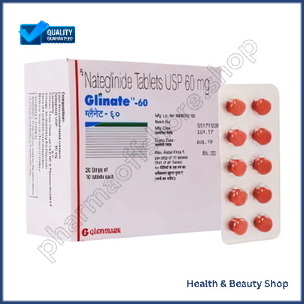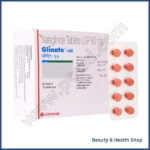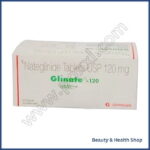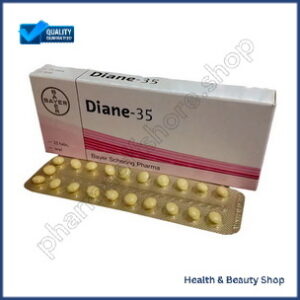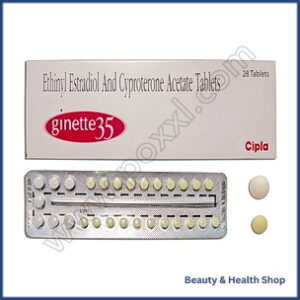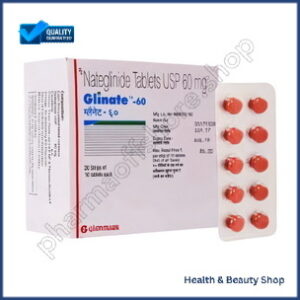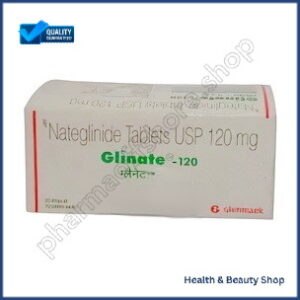ADDICTION
ALCOHOL DEPENDENCE
QUIT SMOKING
ALLERGY
ANTI FUNGAL
FUNGAL INFECTION
FUNGAL NAIL INFECTIONS
ANTI-REJECTION DRUGS
ANTI WORM
ANTIBIOTIC
BACTERIAL INFECTIONS
ARTHRITIS
GOUT
OSTEOARTHRITIS
RHEUMATOID ARTHRITIS
BLOOD
LOW PLATELET COUNT
THROMBOPHLEBITIS
VARICOSE VEINS
COLON
ANAL FISSURE
PILES
ULCERATIVE COLITIS
DIABETES CARE
DIABETES INSIPIDUS
DIABETES TYPE
DIABETIC FOOT ULCERS
GLUCOSE MONITOR
EYES/EAR CARE
DRY EYES
EYE CARE
EYE EXAMINATION
EYE INFECTION
EYE LASHES
EYE PAIN
GLAUCOMA
OCULAR HYPERTENSION
UVEITIS
FEVER CARE
MALARIA
RHEUMATIC FEVER
TYPHOID FEVER
GASTROINTESTINAL
ACIDITY
CONSTIPATION
CROHN'S DISEASE
DIARRHOEA
GALLBLADDER STONES
INTESTINAL ULCERS
IRRITABLE BOWEL SYNDROME
MOTION SICKNESS
NAUSEA
Glinate (Nateglinide)
Glinate 60 mg (Nateglinide)
Glinate 120 mg (Nateglinide)
| Active Ingredient (Generic Name): | Nateglinide |
|---|---|
| Indication: | Type 2 diabetes |
| Manufacturer | Glenmark Pharmaceuticals Ltd. |
| Packaging: | 10 tablets in one strip |
From: $26.00
Glinate (Nateglinide) helps manage blood sugar levels in type 2 diabetes by stimulating insulin production to lower blood sugar post-meals. Follow healthcare provider’s dosing instructions, typically taken 1 to 30 minutes before meals, 2-4 times a day, based on individual response. Consult your provider for off-label uses and potential drug interactions. Eat balanced meals regularly, avoid skipping meals, and drink water adequately. Store Glinate in a cool, dry place, and seek help in emergencies or overdoses. Inform your healthcare provider of all medications and monitor blood sugar levels consistently. Explore brand names like Starlix and purchase from licensed sellers for authenticity.
Why is this medication prescribed?
Nateglinide, commonly known as Glinate, is prescribed to help control blood sugar levels in individuals with type 2 diabetes. This medication belongs to a class of drugs called meglitinides, which work by stimulating the pancreas to produce more insulin after meals. By increasing insulin production, Nateglinide helps to lower blood sugar levels, especially after eating.
For individuals with type 2 diabetes, maintaining stable blood sugar levels is vital in managing the condition and preventing complications. Glinate is typically prescribed to be taken before meals to help regulate blood sugar spikes that can occur after eating. It’s important to follow your healthcare provider’s instructions carefully when taking this medication, including the timing and dosage recommendations.
How should this medicine be used?
When using this medication, follow the dosage instructions provided by your healthcare provider to effectively manage your blood sugar levels.
Glinate (Nateglinide) is typically taken orally before meals, usually 1 to 30 minutes before each main meal. The dosage will depend on your individual medical condition and response to treatment. It’s important to take this medication as directed by your doctor, typically 2-4 times a day.
Remember to take Glinate with a meal to help reduce the risk of low blood sugar (hypoglycemia). If you skip a meal, you should also skip the dose to avoid hypoglycemia. Don’t take a double dose to make up for a missed dose.
Regularly monitor your blood sugar levels as advised by your healthcare provider to ensure the medication is effectively managing your condition. If you have any questions or concerns about how to use this medicine, don’t hesitate to consult your healthcare provider for clarification and guidance.
Other uses for this medicine
To explore additional applications for Glinate (Nateglinide), consider its potential off-label uses as recommended by your healthcare provider. While Glinate is primarily prescribed to manage blood sugar levels in individuals with type 2 diabetes, some healthcare providers may recommend it for other purposes.
One potential off-label use of Glinate is for managing postprandial (after-meal) glucose spikes in diabetic patients. By taking Glinate before meals, it may help control blood sugar levels more effectively during the critical post-meal period.
Additionally, some studies suggest that Glinate could potentially aid in weight management for individuals with diabetes, although further research is needed to confirm its efficacy for this purpose.
Consult your healthcare provider before using Glinate for any off-label purposes to make certain it’s safe and appropriate for your specific health needs. Your healthcare provider can provide guidance on whether Glinate may be beneficial for you beyond its approved indications.
What special precautions should I follow?
When using Glinate (Nateglinide), it’s essential to check for any potential drug interactions to guarantee your safety and the effectiveness of the medication.
Be vigilant about communicating with your healthcare provider or pharmacist about any other medications or supplements you’re taking to prevent adverse effects.
Following this precaution will help you manage your health condition effectively while minimizing the risk of complications.
Check for Drug Interactions
To guarantee your safety and maximize the effectiveness of Glinate (Nateglinide), it’s essential to verify for potential drug interactions.
- Consult Your Healthcare Provider: Before starting Glinate, discuss all medications, supplements, and herbal products you’re taking with your healthcare provider.
- Watch for Signs of Interactions: Be vigilant for symptoms like dizziness, nausea, or changes in blood sugar levels, which could indicate a possible drug interaction.
- Inform About Allergies: Make sure to inform your healthcare provider about any known drug allergies to prevent adverse reactions.
- Regularly Review Medications: Periodically review your medication list with your healthcare provider to identify and address any potential drug interactions promptly.
What special dietary instructions should I follow?
You should adhere to specific dietary guidelines while taking Glinate (Nateglinide) to maximize its effectiveness. It’s recommended to take this medication 30 minutes before a meal. Since Glinate is a rapid-acting medication that helps control blood sugar levels after meals, timing is pivotal for its effectiveness. Be consistent with your meal times to guarantee a regular schedule for taking Glinate.
When it comes to your diet, focus on consuming a balanced meal that includes carbohydrates, proteins, and healthy fats. Avoid skipping meals, especially when taking Glinate, as it may lead to low blood sugar levels. Opt for whole grains, lean proteins, fruits, and vegetables to maintain stable blood sugar levels. Limit your intake of sugary and high-carbohydrate foods that can spike blood sugar levels.
Additionally, stay hydrated by drinking an adequate amount of water throughout the day. Water is essential for various bodily functions, including the proper metabolism of medications like Glinate. By following these dietary instructions, you can help optimize the effectiveness of Glinate in managing your blood sugar levels.
What should I do if I forget a dose?
If a dose of Glinate (Nateglinide) is missed, promptly take it with food within an hour of the scheduled time. Missing a dose can affect your blood sugar levels, so it’s important to try and take the missed dose as soon as you remember.
However, if it’s almost time for your next dose, skip the missed one and continue with your regular dosing schedule. Don’t take a double dose to make up for the missed one, as this can lead to an overdose.
It’s advisable to set reminders or alarms to help you remember your doses and maintain a consistent schedule. If you frequently forget doses, consider using a pill organizer to help keep track of your medication.
Always consult your healthcare provider if you have any concerns about missed doses or if you’re unsure about what to do in such situations.
What side effects can this medication cause?
Glinate (Nateglinide) can cause side effects that may persist, with some being serious. If you experience symptoms such as prolonged dizziness, severe stomach pain, or difficulty breathing, it’s vital to contact your doctor promptly.
Monitoring and reporting any ongoing or severe side effects to your healthcare provider is essential for your well-being.
Report Persistent Side Effects
Experiencing persistent side effects from Glinate, also known as Nateglinide, can greatly impact your daily life and overall well-being. These side effects may vary in severity and duration, potentially causing discomfort and inconvenience. It’s essential to be aware of the possible adverse reactions to this medication, which may include:
- Nausea and vomiting
- Diarrhea or constipation
- Headaches or dizziness
- Muscle pain or weakness
Monitoring and reporting these persistent side effects to your healthcare provider promptly is vital for effective management and adjustment of your treatment plan. Prioritizing your well-being by staying vigilant and proactive in addressing any discomfort can lead to better health outcomes and improved quality of life.
Some side effects can be serious. If you experience any of the following symptoms, call your doctor immediately:
When encountering certain symptoms while taking Glinate (Nateglinide), contacting your doctor promptly is essential due to the potential seriousness of these side effects. Some side effects can be severe, and if you experience any of the following symptoms, it’s important to seek medical attention immediately:
- Persistent nausea or vomiting
- Unusual fatigue or weakness
- Yellowing of the skin or eyes
- Severe abdominal pain
These symptoms could indicate a serious reaction to the medication that requires immediate medical evaluation. It’s important not to ignore these signs and to reach out to your healthcare provider promptly for further guidance and appropriate management.
Your well-being is paramount, and addressing these symptoms promptly is crucial for your safety and health.
What should I know about the storage and disposal of this medication?
To maintain the effectiveness of Nateglinide, store it in a cool, dry place away from direct sunlight and moisture. It’s advised to keep the medication at room temperature between 68-77 degrees Fahrenheit. Avoid storing it in the bathroom or kitchen where humidity levels can fluctuate. Keep the medication in its original packaging or container to safeguard it from light and moisture. Make sure that the packaging is tightly closed when not in use to prevent exposure to air and humidity, which can impact the medication’s potency.
When it comes to disposal, follow proper guidelines to guarantee the safe and environmentally friendly disposal of Nateglinide. Don’t flush the medication down the toilet or pour it down the drain unless directed to do so. Consult your pharmacist or local waste disposal facility on the correct way to dispose of unused or expired medication. Some pharmacies offer drug take-back programs for safe disposal. If such programs aren’t available, mix the medication with unpalatable substances like dirt or cat litter in a sealed bag before discarding it in the trash to prevent accidental ingestion.
In case of an emergency/overdose
In an emergency or overdose situation with Nateglinide, immediately contact poison control or seek medical assistance. Symptoms of an overdose may include confusion, dizziness, sweating, tremors, rapid heartbeat, or fainting.
It’s important to provide healthcare providers with information about the amount of medication taken and the time of ingestion. Don’t induce vomiting unless instructed by medical professionals. If someone collapses or has trouble breathing, call emergency services right away.
Keep the medication packaging with you so that healthcare providers can easily identify the medication. Don’t delay seeking help in the case of a suspected overdose, as prompt medical attention is essential in managing the situation effectively. Poison control centers are equipped to provide guidance on the next steps to take.
Follow their instructions carefully and cooperate with healthcare professionals to ensure the best possible outcome in case of an emergency or overdose involving Nateglinide.
What other information should I know?
If you’re prescribed Nateglinide, it’s important to be aware of potential drug interactions and side effects. Before starting this medication, inform your healthcare provider about all the medicines, supplements, and herbal products you’re currently taking to avoid any adverse interactions. Nateglinide may interact with certain drugs like beta-blockers, gemfibrozil, or rifampin, impacting its effectiveness or causing harmful effects.
It is vital to monitor your blood sugar levels regularly while taking Nateglinide to make sure it’s effectively controlling your diabetes. Be mindful of symptoms of low blood sugar such as sweating, shakiness, or confusion, and always have a source of sugar on hand in case of emergencies. Additionally, be cautious while consuming alcohol as it can affect your blood sugar levels and increase the risk of side effects.
If you experience any unusual symptoms or side effects while taking Nateglinide, promptly contact your healthcare provider for guidance. Stay vigilant and informed about how this medication may impact your health to guarantee its safe and effective use in managing your diabetes.
Brand names
When considering Nateglinide, it’s important to be mindful of its brand names to make sure you are using the correct medication. This medication is commonly known by its brand name Glinate in various countries. Understanding these brand names can assist you in identifying the right medication when purchasing or discussing it with healthcare providers. Below is a table listing some of the brand names under which Nateglinide is marketed globally:
| Brand Name | Country |
|---|---|
| Glinate | Worldwide |
| Starlix | United States, Canada |
| Fastic | Japan |
| Senaglinide | South Korea |
| Natrilix | Australia |
Make sure to check with your healthcare provider or pharmacist if you are unsure about the brand name under which Nateglinide is available in your region. This can help you receive the correct medication and avoid any confusion during your treatment.
Purchase Locations
When considering purchasing Nateglinide, explore various pharmacies and online retailers for availability. Nateglinide, commonly sold under the brand name Glinate, is a medication used to treat type 2 diabetes by helping to control blood sugar levels.
When looking to purchase Nateglinide, start by checking with local pharmacies such as CVS, Walgreens, or Rite Aid. These brick-and-mortar stores often carry a range of diabetes medications and may have Nateglinide in stock. Additionally, consider exploring online retailers like HealthWarehouse or Healthline Pharmacy, which offer the convenience of ordering medications from the comfort of your home and may have competitive pricing.
It’s essential to make sure that whichever location you choose to purchase Nateglinide from is reputable and licensed to sell prescription medications. Check for customer reviews, verify the legitimacy of the website or store, and confirm that the medication being sold is authentic and approved by regulatory authorities.
To summarise
Wondering how to efficiently summarize the information on purchasing Nateglinide from various locations?
When summarizing the purchase locations for Nateglinide, it’s crucial to take into account online pharmacies, local pharmacies, and international options.
Online pharmacies offer convenience and sometimes lower prices, but make sure the pharmacy is legitimate and follows safety regulations.
Local pharmacies provide face-to-face interactions with pharmacists and immediate access to the medication, but prices may vary.
International options might offer cost savings, but be cautious of counterfeit products and shipping times.
When deciding where to purchase Nateglinide, compare prices, consider shipping costs, and factor in reliability and safety.
Always consult your healthcare provider before buying Nateglinide to ensure it’s the right medication for you.

